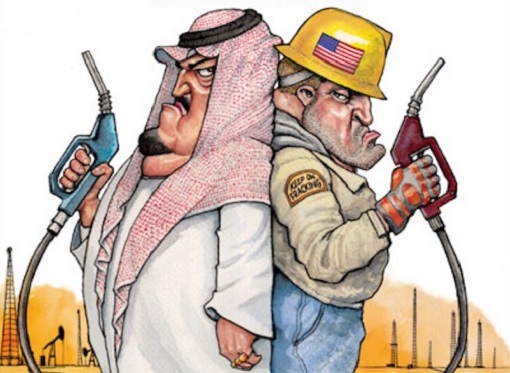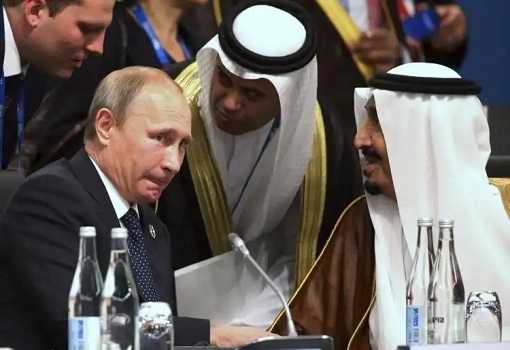Brent crude oil is struggling to stay above US$60 while WTI crude oil has already gone below that level. It’s a matter of time before this psychology level is tested. When the Brent couldn’t hold above US$60 a barrel anymore, all hell will break loose. It took Brent 42 days to skyrocket from US$62 to US$71. But 10 days were all it needed to plunge from US$71 to US$62.
In short, a pullback last week has wiped out its gains for 2018. And the pullback could just be the beginning of something much worse for OPEC. The year 2017 belonged to OPEC. Since the middle of 2017, oil prices have skyrocketed about 40% – from US$46 to US$66 a barrel. OPEC countries were practically laughing all the way to the bank.
How did OPEC win its battle in 2017 after lost a humiliating war in 2016 to the U.S. shale producers? They won after Saudi Arabia successfully convinced Russia and 10 other allied producers to cut production in order to clear supply glut. The output cut by 1.8 million barrels a day was working beautifully, so much so that they conveniently extended the trick to the rest of 2018.

Now, the Saudi-led oil cartel isn’t sure if they could afford to wait until the end of the year. Their magic wand isn’t working anymore. True, rising U.S. crude exports is the primary culprit. In November 2017, the U.S. oil production rose to 10.038 million barrels a day. Now, U.S. Energy Information Administration (EIA) preliminary figures show production is running at 10.25 million barrels a day.
Effectively, the U.S. has surpassed Saudi Arabia’s output. In fact, the Americans are producing so much oil that they even sell oil to the Arabs. U.A.E., a Persian Gulf petro-state which earns endless billions of dollars from crude exports apparently bought oil directly from the U.S. in December 2017 – to the tune of 700,000 barrels of light domestic crude in that month alone.
But there’re two signs that have really gotten into the Saudi’s nerve. First sign is the emerging of super tankers in the business. This week in Louisiana, the first super tanker – “Shaden” – was chartered by Shell Oil to carry a cargo of medium sour crude. The super tanker, like U.S. Navy aircraft supercarrier, is the biggest of its kind capable of carrying 2 million barrels of crude.

Also known as VLCC, or very large crude carrier, super tanker like Saudi-owned Shaden is a big deal in oil industry. With reports that more super tanker such as “Anne” joining the logistic business of carrying huge amount of crude, it means America is on track to become a net energy exporter by 2022 – 4 years earlier than forecasted – as predicted by the U.S. EIA.
While OPEC’s plan of draining oil glut has been working, the plan nevertheless is spoilt by none other than U.S. shale drillers – again. After Saudi delivered a “bloody nose” to the American drillers, they’re back with vengeance. OPEC’s official goal is to drive down inventories to the five-year average. It has been working – until now.
At the start of last year, there were 264 million barrels above that level. Now, they are just 52 million barrels higher than OPEC’s target. The victory is so near yet so far. On Tuesday, Paris-based International Energy Agency warned that surging U.S. production could delay OPEC’s bid to balance the long-oversupplied oil market.

“Today, having cut costs dramatically, U.S. producers are enjoying a second wave of growth so extraordinary that in 2018 their increase in liquids production could equal global demand growth,” – IEA said. What this means is America production could climb enough this year to satisfy the 1.4 million additional barrels a day that IEA forecasts the world will consume in 2018.
Even OPEC itself warned on Monday that it might not achieve its goal until the end of 2018. More importantly, IEA warns that history might be repeating itself – a history whereby the Saudi launched “a price war” on U.S. shale oil, hoping to flush high-cost U.S. drillers out of the market. Today, of course, many shale drillers proved they could keep pumping with oil prices below US$50 a barrel.
There’s a second sign which could change the oil export game in favour of America. Analysts and experts are wary of Russia’s commitment, especially as U.S. crude oil exports have surged to record highs. If the trends continue, American output will shoot to 11.2 million barrels by next year (2019); effectively overthrowing Russia as the ultimate top crude oil producer on planet Earth.

Russia is concerned that if they do nothing, considering the United States share market is growing while the oil prices are crashing, there would be nothing left to do eventually. Russia could lose China’s market to America. Even though President Vladimir Putin and Russian Energy Minister Alexander Novak have assured Saudi that Russia will not abandon the deal, nothing is cast in stone.
After all, Russia’s oil and gas giants are seen as reluctant participants in the agreement with Saudi Arabia. Unlike the state-owned oil companies of OPEC, Russian energy giants are publicly-traded enterprises with shareholders. Alexander Dyukov, CEO of Russia’s Gazprom Neft, said he hoped producers would agree to raise output since the market has balanced after years of oversupply.
Other Articles That May Interest You …
- Oil Crashes!!! U.S. Produces So Much Oil That They Even Sell To The Arabs
- U.S. Oil On Its Way To Beat Saudi & Russia – Tops 10 Million Barrels / Day Since 1970
- If Oil Goes Above $70, The Complacent & Lazy Saudi Might Not Reform At All
- U.S. Oil Producers Eating Up Asian Market, And There’s Nothing OPEC Can Do
- Here’s How Oil Could Crash To $10 – In 6 To 8 Years
- Karma Is A Bitch! – Desperate Saudi Whines & Begs U.S. Not To Pump So Much Oil
- Meet United States – The World’s Latest Oil Exporter – After 40 Years
- Here’s Why Oil Above $100 Will Never Happen Again, Ever, Forever!!

|
|
February 15th, 2018 by financetwitter
|


|

|

|

|

|

|




























Comments
Add your comment now.
Leave a Reply